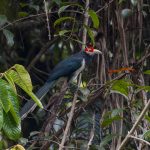If your diet usually consists of dry seeds, imagine how luscious and shlurpy a long strand of algae must feel. These little Lonchura finches were sucking it up like spaghetti after plucking it from a small puddle in a Hong Kong wood recently. I had never noticed them do this before and until now, had assumed that they were exclusively granivorous. To find out if this was normal behaviour, I made a search on the internet. There I found a study which showed that the ingenious little birds had found a protein source that allowed them to coincide their breeding with times of man-made, rather than natural seasonal abundance. The study was conducted on a population of Striated Munias, Lonchura striata, but it would seem that they are not the only species to take advantage of the body-building power of algae.
White-backed / Striated Munia Lonchura striata
Munias or mannikins (but not manakins), are small, seed-eating finches from Africa, Asia and Australia. They are popular as caged birds and escapees have established a number of feral populations beyond their normal ranges. For example, the Nutmeg Munia, Lonchura punctulata, has managed to maintain a presence in California and Florida for some years.
Nutmeg Mannikin Lonchura punctulatus
They are common in Asia where cultivated rice makes up a large percentage of their diet, to the extent that breeding has become linked to the rice-growing cycles rather than natural seasonal triggers of rainfall, day length or insect availability. Sedentary populations can breed twice a year, coinciding with the time of rice abundance in their locality and have been able to drop their dependence on natural seasonal factors.

Nutmeg Mannikin Lonchura punctulatus
However, grass and rice seed is low in the protein needed to encourage gonadal growth in preparation for the breeding season. Most other birds that breed in harmony with the natural seasons can enhance their diet with insect protein, but the Lonchura finches have found a supplementary source to enable them to take advantage of the rice-growing cycles.
White-backed / Striated Munia Lonchura striata
Fertilisers used to boost rice production also promote the growth of Spyrogira algae in the drainage ditches and pools of this water-based agriculture. Studies have shown that the protein content of the filamentous algae is much higher than other sources available to the finches and it is this dietary supplement that enables them to be physiologically developed and ready to breed in time for the ripening rice. Clever things!
















That is so cool – algae-eating finches! Thanks for sharing!!